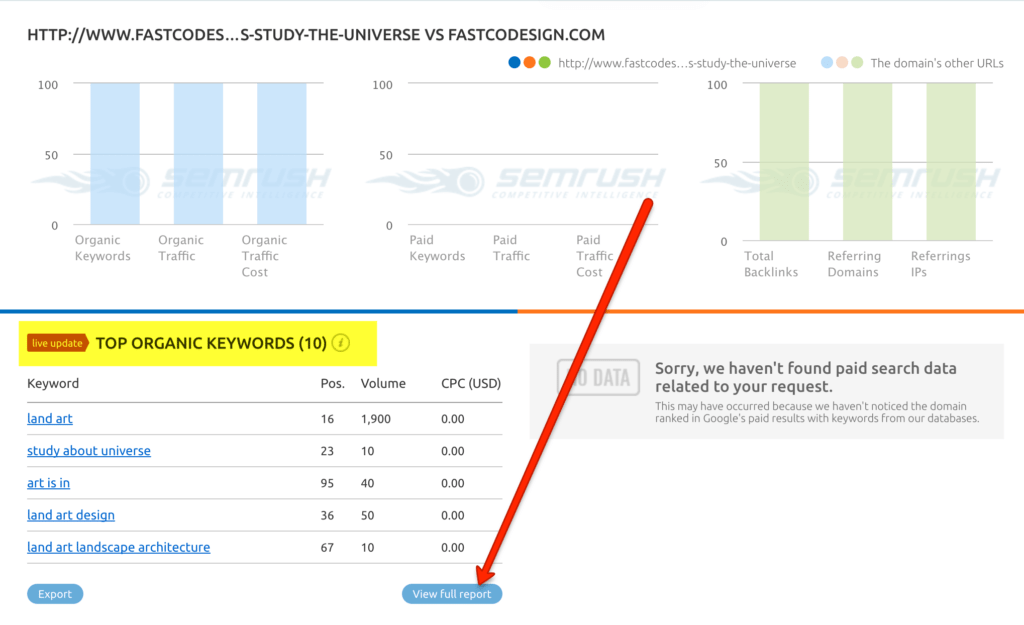How To Design an SEO Content Map
- Nick Eubanks
- Jul 26, 2016
- 7 min read
Updated: Apr 3
When it comes to building content over time to increase your search engine rankings, one analogy immediately comes to mind:
The first time I heard this term was Amy Hoy using it to describe building products, and in similar fashion I'm using it to describe the process of building a house of organic rankings. Just like Amy describes
as being built brick-by-brick, so is SEO - you just need to make sure you're using the right bricks.
Building Your SEO Bricks
Building a base of content designed around contextually relevant and interconnected topics is just like building a house, you need to:
Define your requirements and what your house needs to have.
Design a blueprint to figure out where things will be built.
Develop the structures that are needed to support your requirements.
Let's talk more about these one at a time;
1. Defining Your Requirements
When it comes to SEO, requirements are defined by keyword research and prioritization. Once you have your list of target keywords and associated targeting timelines, i.e. immediate, short-term (3 to 6 months), and long-term (12+ months), then it's time to go to work analyzing your competitors. What you're looking for here is to adjust and validate your priorities based on your target keywords individual rank potential. The goal of your requirements is to crack rankings and gain traction (
) as quickly as possible for qualified queries. It's OK to start with less than ideal keywords,
- and you're able to acquire the traffic quickly and easily.
As you begin building up traffic and relevancy, it gets easier to begin targeting better, more difficult keywords.
Content requirements can take on a lot of forms, but generally the criteria that I want to see when reviewing requirements are:
Audience - who is this content being created for?
Stage - which part of the conversion funnel does this content support?
Target Keywords - self explanatory :)
Meta Attributes
Title
Slug (or URL if you prefer)
Page Description (used for meta description)
Social Description (should be different for each social channel)
Length - I prefer this is based on data from within the vertical, both Sentinel and Clearscope are very helpful with dialing this in.
Internal Links - yup you guessed it, which pages on the site will have links to this page, how will it be linked (i.e. text, image, buttons, etc.) and what will the anchors be. Will it be included in any navigational elements?
Media - what types of media will this content contain; images (how many?), videos (which ones?), quotes (from who?)
Links - how many links does this content need to crack page one for the target keywords? Again, sentinel is very useful for this.
2. Designing a Blueprint
Building your blueprint depends heavily on your target keywords and your decided priorities. Once you've honed in on the rank potential for your terms, and adjusted your SEO timelines accordingly, you can start to design a keyword strategy that includes mapping content to your keywords. One of the first steps in creating your blueprint is to analyze your requirements list and identify content themes or categories (think of these like buckets). Ideally you want to come up with somewhere around 10, up to a max of 15 or so. The purpose is to keep these high-level, but if your broad topic is already a niche inside a niche, like let's say you're a construction company that focuses on excavating, then you would want to expound on topics within the sub-niche of excavating, like
for rail tunnels,
for city streets, or even
.
3. Developing The Structure
Now you can begin to flesh out the requirements for your content - my newest favorite tool for doing this is Lumanu; it's like BuzzSumo and Jarvis from Ironman
. I use Lumanu to build topic lists using favorites, and then group my favorites together to create what Lumanu calls their "insights report," which is where the really smart magic happens. The tool's insights are split into 2 main sections;
- here's a snapshot of the influencer insights:

Each of which can be drilled into for more details:
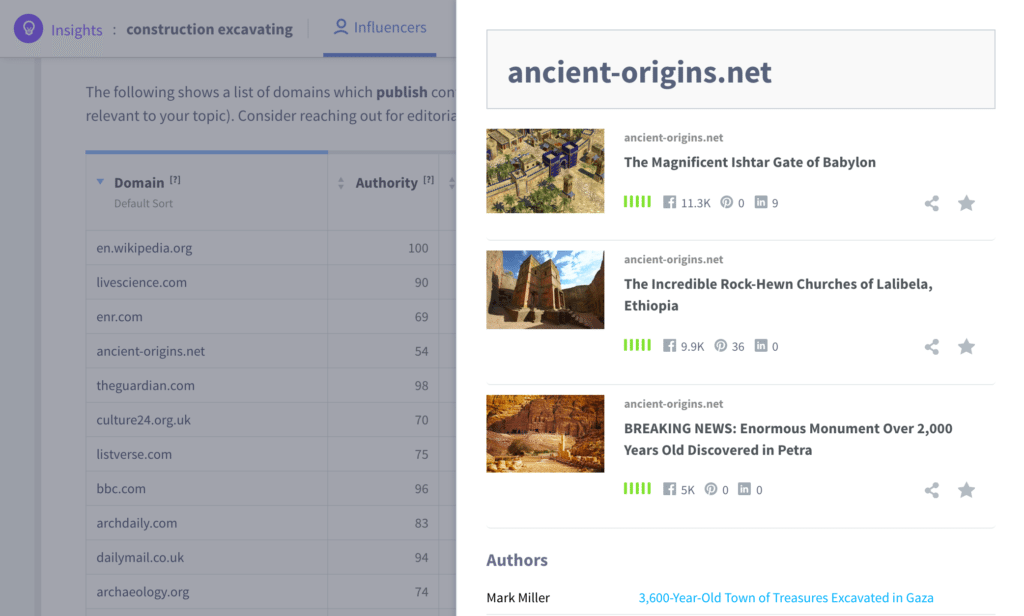
and here's a snapshot of the content insights:
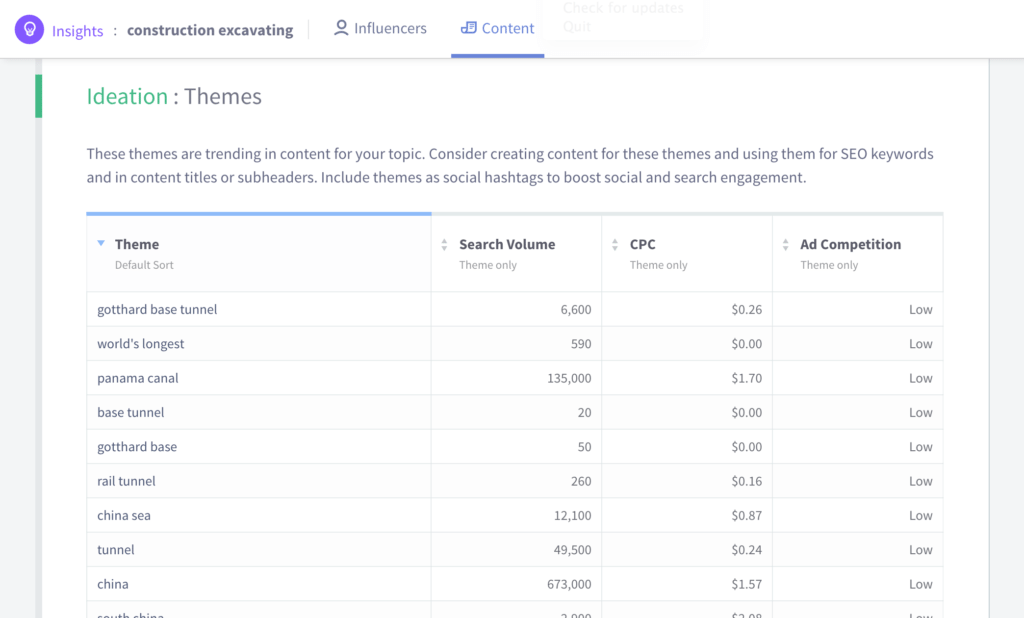
and here's a look at what makes me
excited about this:
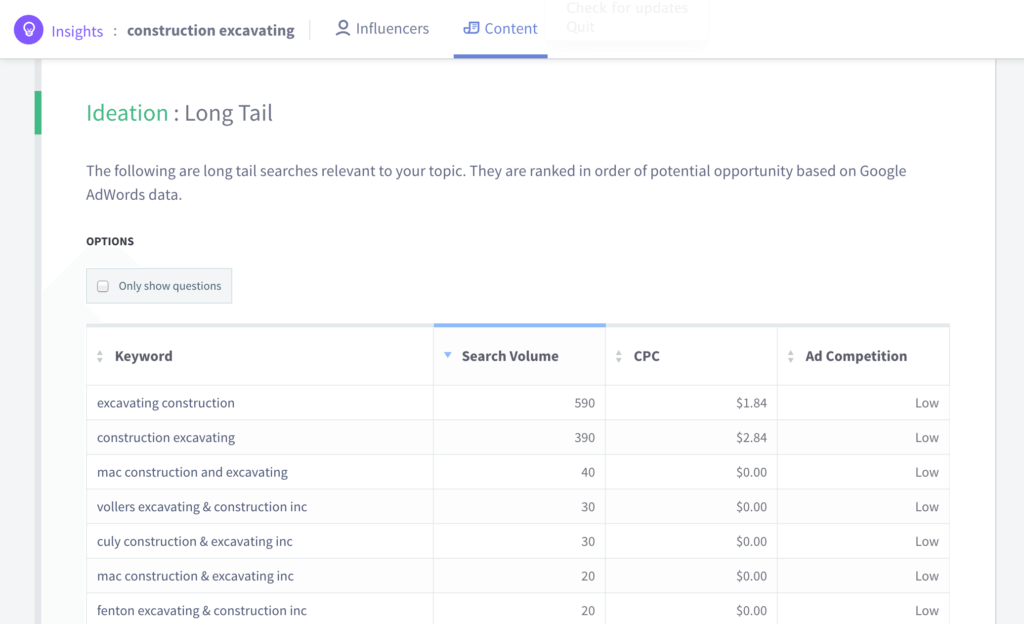
and taking this even further, you can drill into content examples based on specific success criteria and heuristics:

With the requirements for your content in hand, now you can begin to stack the bricks. It starts with building out the cornerstone content that will be needed to establish the relevance your after, let's just look at this blog (especially since at this point
).
internal link development (this post)
SEO ROI
and a few other surprises
Notice anything?
That's my roadmap for content development, I'm building posts that act as the scaffolding to connect the topics around my site. The next step is to build the rooms (individual posts within the topic areas), and then connect the rooms with hallways,
. If you look back over that list, you can quickly see that I'm about halfway done building out the initial seed content for my internal content map -
.
Backing Into Your Content Map
Maybe you have an existing site, or your doing work on a client site, where you already have a content catalog to work from and most of the important pages exist,
.
Here's where a content audit can work wonders from an SEO perspective.
My favorite process for this, and the one we use at FTF, is to do a content gap analysis.
To get you started on what can be a daunting process depending on the size of your website, check out this wonderful post on how to build a content inventory and this post on how to do a content audit.
Essentially you're taking inventory of all your existing pages, tagging them into keyword buckets and themes, and then finding the gaps where content needs to be created or repurposed.
TIP: While auditing your content - make a note, even if that content doesn't exist yet, once it's created make sure you go back to these pages and add in those links.
Refreshing and Adding Content
One of the easiest ways to blow out your existing SEO is by leveraging content to find opportunities to poach rankings. My favorite way to do this is to find pages on your site that are already ranking,
, that are pretty thin in terms of both content and link authority.
Once you know which pages need some love it's not hard to create a priority list by cross-referencing your keyword targets.
So start by analyzing existing content for keywords that are already in place - that should be supported with dedicated content (think of these as adding re-enforcements to your house).
My favorite way to do this is to drop a URL into SEMRush, download the keyword rankings report, and then filter the rankings column for greater than 10.
is to use a constrained filter by setting it to greater than 10 but less than 20 - so you can first look at your page 2 poaching opportunities. Then the next step is to quickly beef up the link authority of these pages you want to move up in Google's rankings - and the easiest way to do this is to add links that are both trusted and guaranteed (
from YOUR website, i.e.
). Here's an example from policygenius.com where their
:
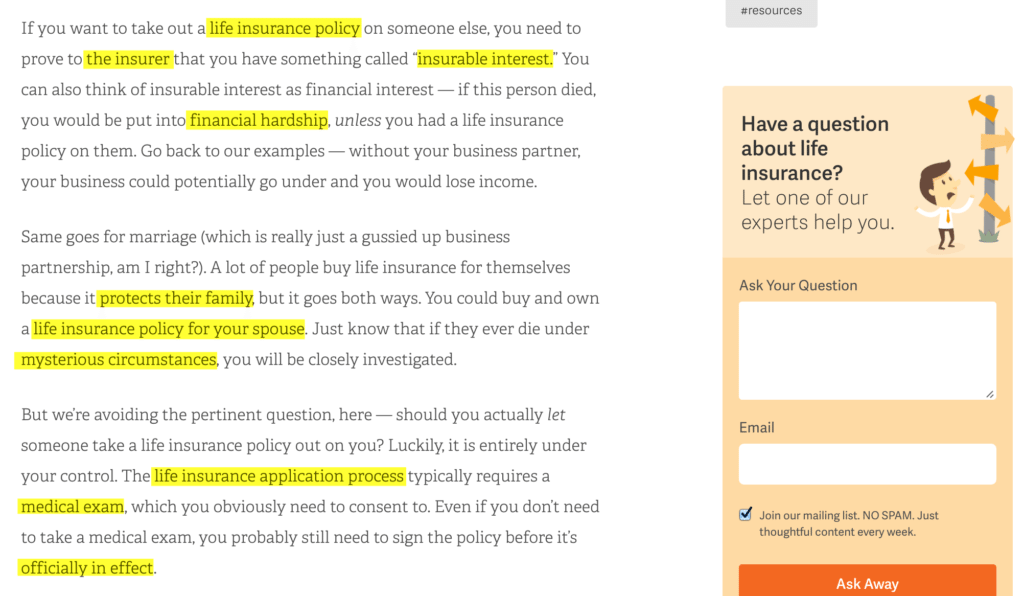
^If you review that picture you can see I've highlighted terms that already existed naturally on the page that would be great topics to reinforce the topical relevancy of the page.
In order to maximize the link juice of the pages you're building new internal links to, find pages on your site that have the highest link authority, using a 3rd party link metric like Ahrefs or even page authority.
Identifying New Content Opportunities
In some instances while working on your content map you'll realize that there are naturally occurring keywords within your content that would be great keyword rich internal links - but you have nowhere for them to link to. Coming back to the above example on policygenius.com, let's see if they have a good place to link that first keyword to, to do this I'm just going to fire up big G and punch in
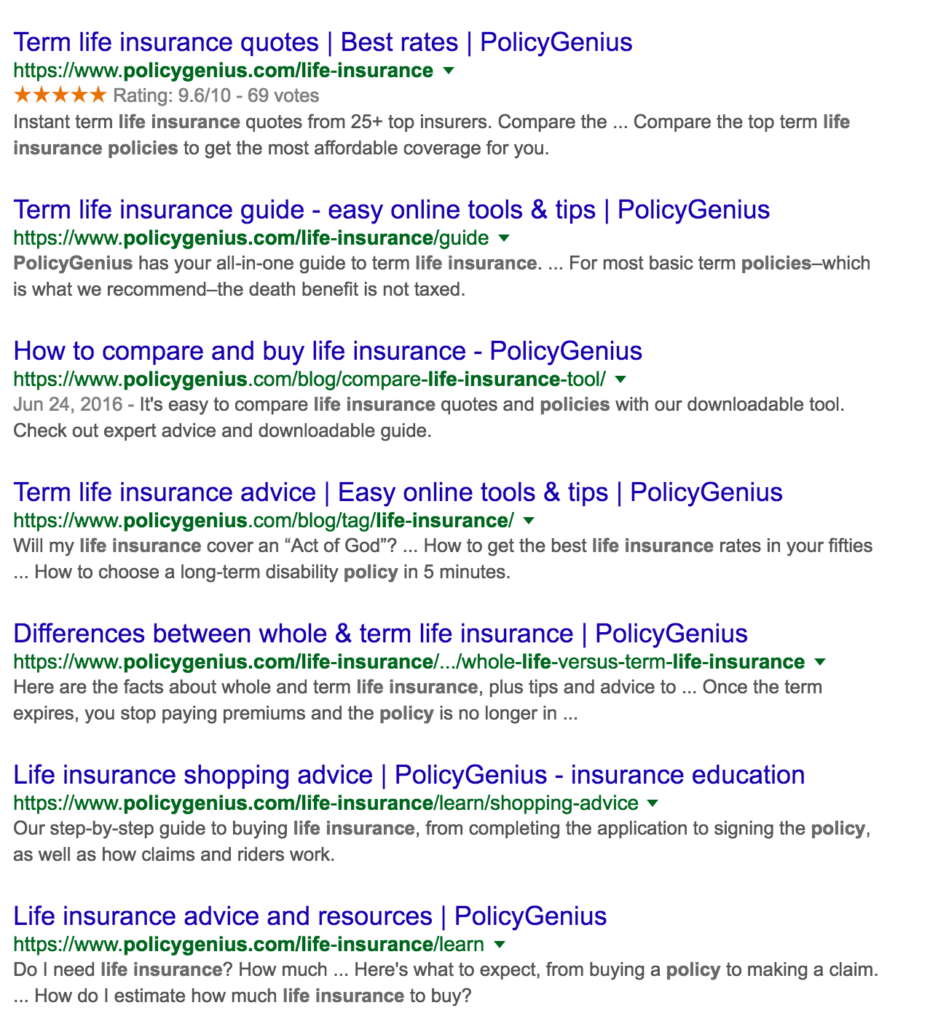
That was easy, the number one result is the ideal place to link to.
Let's try one more, how about the next keyword opportunity from that example paragraph - I'm going to do the same for "the insurer:"
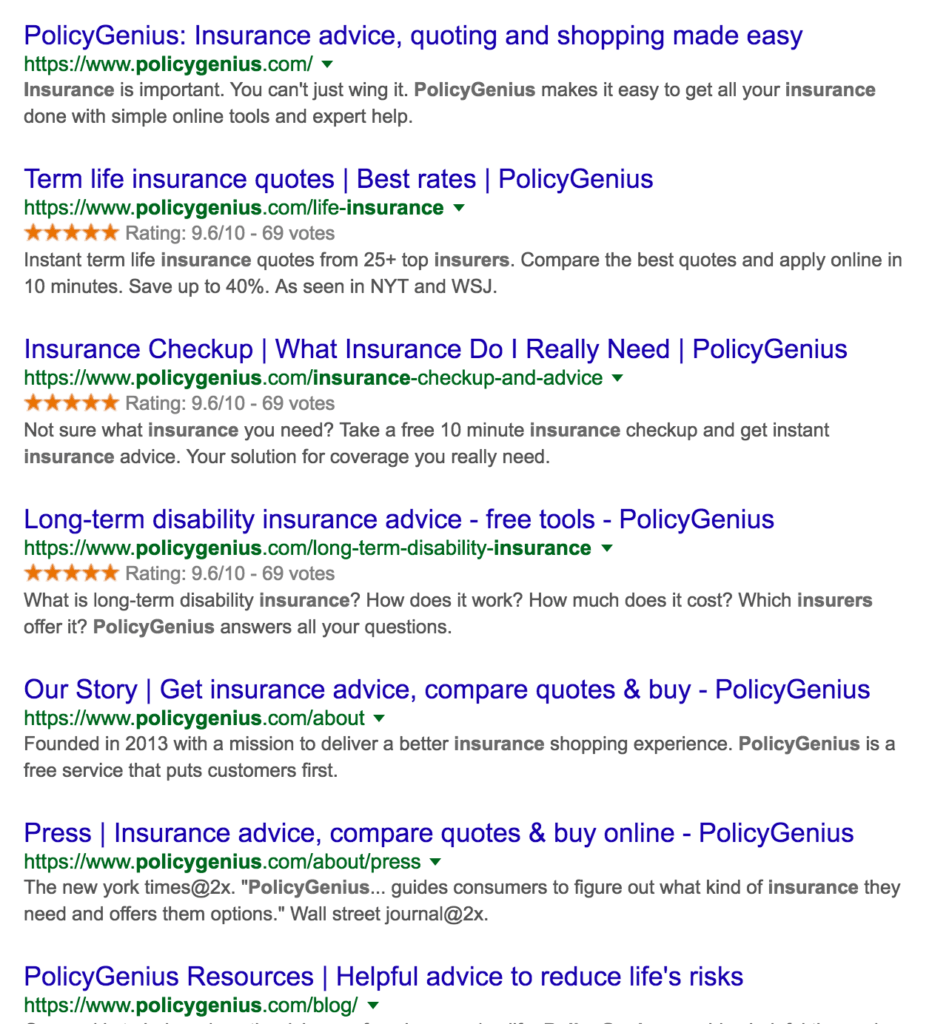
No dice.
So this would be the a piece of content I would add to my content map and consider creating. I'm honestly surprised a site like Policy Genius doesn't have a glossary for terms like this.
An Important Consideration
Gone are the days of "
," and what I mean by that is there was once a time where it was considered a good idea, even a best practice by some, to create a page for every keyword you wanted to rank for.
Instead of just throwing stones (
), modern SEO requires you to build sturdy websites made with bricks. You need to be smarter and more intentional with your content development. Google's ability to comprehend and predict LSI,
, is only going to get better. A great re-enforcement of this is how sometimes the best thing you can do for your site's content is to kill it.
Please take a second in the comments and let me know if my whole house analogy for this SEO strategy makes any sense -
.

